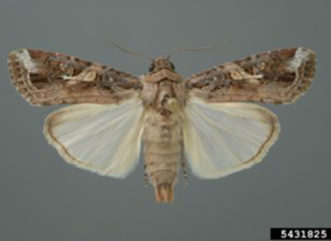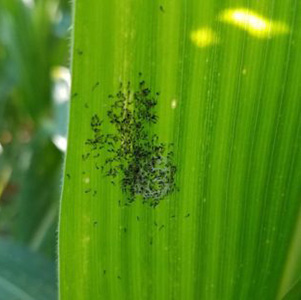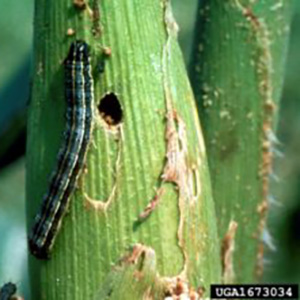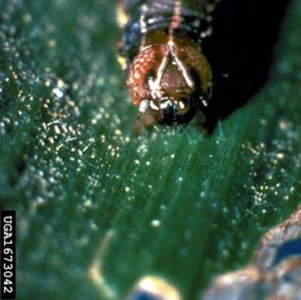The fall armyworm (Spodoptera frugiperda, FAW) is native to the Americas where it is known to be a pest of numerous crops. The insect overwinters in North America in south Florida, Texas, Mexico, and the Caribbean. Seasonal dispersal from these sites occurs every year, with movement throughout most of the United States from April to August, depending on latitude.1 Arrival in South Carolina varies from year to year, but occurs generally from late May to June. The insect recently expanded its range and has now become a major pest in many parts of Africa2 and Asia.3,4
The highly mobile moth (figure 1) lays eggs in masses of 10 to 600 eggs, though 100 to 200 is more common (figure 2). The insect typically has six larval stages or instars, with pupation occurring in the soil. Late instars (figure 3) can be distinguished from the corn earworm in particular by a light-colored inverted Y-shape on the head (figure 4). The larva can feed on numerous host plants, including crops such as corn, sorghum, cotton, soybean, and many vegetables and grass hosts. Two host strains of the insect exist, which are known as the ‘rice’ and ‘corn’ strains.5 Each strain is characterized by genetic differences, in addition to the corn strain showing preference for larger grasses such as corn and sorghum and the rice strain found mainly on pasture and turfgrasses as well as rice.
Injury to Corn
The FAW can cause leaf, stalk, and ear damage to corn plants. However, the insect prefers to lay eggs and feed on vegetative stage corn (figure 5).6 Larvae feed on leaves, in particular in young whorl leaves, leaving characteristic rows of holes. Corn is generally tolerant of significant leaf feeding by FAW, as plants can compensate for some degree of whorl damage. However, feeding on the apical meristem (i.e., the main growing point of the plant) can lead to stunted plants and plant death.7 Feeding on corn ears can also occur, though injury to ears is less common than whorl feeding.8 This type of ear feeding is similar to corn earworm feeding, but the FAW can often feed through the husk to feed on kernels with less silk feeding than the corn earworm.9 Whorl feeding can impact yield, especially when feeding occurs at earlier vegetative stages.
Management
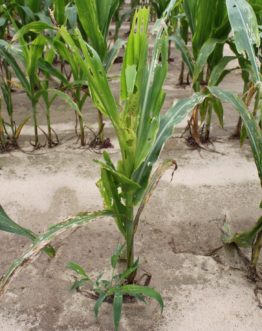
Figure 5. Fall armyworm whorl damage on a corn plant. Image credit: Francis P. F. Reay-Jones, Clemson Cooperative Extension.
Insecticides
Several insecticides are labeled for control of FAW in corn. A recommended threshold for whorl infestation is 25% plants infested with live larvae.10 Because larvae become relatively protected within the whorl as they develop, ground applications directed into the whorl will increase efficacy of insecticides.
Planting Date
Because FAW moths migrate to South Carolina from southern regions, when and where infestations occur in the state can vary substantially. In general, planting corn within the recommended window in South Carolina (mid-March to mid-April) will help to avoid heavy FAW pressure in most years. Planting corn later than in this window increases the risk of heavier pressure.11 Planting early can often be an effective cultural control practice for this insect.
Transgenic Corn Hybrids
A number of transgenic corn products expressing insecticidal toxins from the bacterium Bacillus thuringiensis (Bt) can control FAW (table 1). Levels of control are generally greater with the use of Bt corn than with the use of foliar applications of insecticides alone.11 Bt corn products were originally commercialized for control of the European corn borer, Ostrinia nubilalis, and Bt corn products initially produced a single toxin (Cry1Ab). Over time, the range of Bt toxins has increased, and the majority of available Bt corn products available now express more than one Bt toxin (known as ‘pyramids’). These pyramids generally provide more effective control than Bt hybrids expressing single toxins.8, 12 Research trials in South Carolina have shown that all Bt products can reduce whorl injury from FAW, though Bt products expressing Cry1F alone are not as effective under heavy insect pressure.8, 11 Resistance to Cry1F has been reported in populations of FAW in Puerto Rico,13 Brazil,14 and the southeastern United States,15 so more variable levels of control are expected with this Bt product.
Summary
FAW can cause major damage to corn in the United States, generally by causing whorl-stage damage. The degree of damage is highly variable and is often more severe in late-planted corn. Insecticidal control of FAW in corn is challenging because larvae move into the whorl where they are relatively protected from contact with insecticides. Transgenic Bt corn hybrids provide good to excellent levels of control, though resistance to Cry1F underlines the threat of resistance for durability of Bt products.
Table 1. Relative efficacy of Bt corn products for fall armyworm control.
| Product Trade Name | Bt Protein(s) | Control of FAWa | Refuge requirements in the Southb | Event(s) |
| Agrisure Artesian 3010A | Cry1Ab | F-G | 50% | Bt11, GA21 |
| Agrisure GT/CB/LL | Cry1Ab | F-G | 50% | Bt11, GA21 |
| Agrisure 3000GT, Agrsiure Artesian 3011A | Cry1Ab, mCry3Ac | F-G | 50% | Bt11, MIR604, GA21 |
| Agrisure Viptera 3110 | Vip3Aa20, Cry1Ab | E | 20% | MIR162, Bt11, GA21 |
| Agrisure Viptera 3111 | Vip3Aa20, Cry1Ab, mCry3Ac | E | 20% | MIR162, Bt11, MIR604, GA21 |
| Agrisure Viptera 3220 | Vip3Aa20, Cry1Ab, Cry1F | E | 20% | MIR162, Bt11, TC1507, GA21 |
| Herculex I (HX1) or (HR) | Cry1F | G-VGd | 50% | TC1507 |
| Optimum Intrasect (YHR) | Cry1F, Cry1Ab | VG | 20% | TC1507, MON810 |
| Optimum Intrasect XTRA (YXR) | Cry1F, Cry1Ab, Cry34Ab1/Cry35Ab1c | VG | 20% | TC1507, MON810, DAS-59122-7 |
| Optimum Leptra (VYHR) | Cry1F, Cry1Ab, Vip3Aa20 | E | 20% | TC1507, MON810, MIR162 |
| YieldGard VT Triple (VT3) | Cry1Ab, Cry3Bb1c | F-G | 50% | MON810, MON88017 |
| Genuity VT Double PRO (GENVT2P), Genuity Drought Gard VT Double PRO (GENDGVT2P) | Cry1A.105, Cry2Ab2 | E | 20% | MON89034, NK603 |
| Genuity VT Triple PRO (GENVT3P) | Cry1A.105, Cry2Ab2, Cry3Bb1c | E | 20% | MON89034, MON88017 |
| PowerCore (Dow) | Cry1A.105, Cry2Ab2, Cry1F | E | 20% | MON89034, TC1507, NK603 |
| SmartStax (SSX, Dow) or Genuity SmartStax (GENSS, Monsanto) | Cry1A.105, Cry2Ab2, Cry1F, Cry3Bb1c, Cry34Ab1/Cry35Ab1c | E | 20% | MON89034, TC1507, MON88017, DAS-59122-7 |
| Trecepta | Cry1A.105, Cry2Ab2, Vip3A20 | E | 20% | MON89034, MIR162 |
Adapted from D. Buntin and K. Flanders, 2014, Bt Corn Products for the Southeastern United States. Based on input from entomologists attending the annual Southern Field Crops Management Seminar.
*Note: aE = excellent, VG = very good, G = good, F = fair, P = poor. Excellent usually means better than 95 percent control. Poor means less than about 30% control. bSee Insect Resistance Management (IRM) documentation from the seed companies for additional details. cIndicates a toxin for rootworm control. dResistance to Cry1F has been reported in the southeastern U.S.
References Cited
- Sparks AN. A review of the biology of the fall armyworm. Florida Entomologist. 1979; 62(2):82–87.
- Goergen G, Kumar PL, Sankung SB, Togola A, Tamò M. First report of outbreaks of the fall armyworm Spodoptera frugiperda (JE Smith) (Lepidoptera: Noctuidae), a new alien invasive pest in West and Central Africa. PLoS ONE. 2016; 11(10):e0165632.
- Sidana J, Singh B, Sharma O. Occurrence of the new invasive pest, fall armyworm, Spodoptera frugiperda (JE Smith) (Lepidoptera: Noctuidae), in the maize fields of Karnataka, India. Current Science. 2018; 115:621–623.
- Jing DP, Guo JF, Jiang YY, Zhao JZ, Sethi A, He KL, Wang ZY. Initial detections and spread of invasive Spodoptera frugiperda in China and comparisons with other noctuid larvae in cornfields using molecular techniques. Insect Science. 2019; 11:In press.
- Pashley DP. Current status of fall armyworm host strains. Florida Entomologist. 1988; 71(3):227–234.
- Harrison FP. Observations of the infestation of corn by fall armyworm (Lepidoptera: Noctuidae) with reference to plant maturity. Florida Entomologist. 1984; 67(3):333–339.
- Buntin GD. A review of plant response to fall armyworm Spodoptera frugiperda (JE Smith) injury in selected field and forage crops. Florida Entomologist. 1986; 69(3):549–559.
- Reay-Jones FPF, Bessin RT, Brewer MJ, Buntin DG, Catchot AL, Cook DR, Flanders KL, Kerns DL, Porter RP, Reisig DD, Stewart SD, Rice ME. Impact of Lepidoptera (Crambidae, Noctuidae, and Pyralidae) pests on corn containing pyramided Bt traits and a blended refuge in the southern United States. Journal of Economic Entomology. 2016; 109(4):1859–1871.
- Morrill WL, Greene GL. Distribution of fall armyworm. 1. Regions of field corn plants infested by larvae. Environmental Entomology. 1973; 2(2):195–198.
- Buntin GD. Insect control, pp. 97-99. In A Guide to Corn Production in Georgia. University of Georgia College of Agricultural and Environmental Sciences, Cooperative Extension, Crop and Soil Sciences.
- Bilbo T. Development of Helicoverpa zea (Lepidoptera: Noctuidae) in transgenic corn producing Bt toxins and implications for resistance [dissertation]. Clemson (SC): Clemson University, Department of Plant and Environmental Sciences; 2019.
- Reisig DD, Akin DS, All JN, Bessin RT, Brewer MJ, Buntin DG, Catchot AL, Cook D, Flanders KL, Huang F, Johnson DW, Leonard BR, McLeod PJ, Porter RP, Reay-Jones FPF, Tindall KV, Stewart SD, Troxclair NN, Youngman RR, Rice ME. 2015. Lepidopteran injury to corn containing single and pyramided Bt traits, and a refuge blend with Cry1Ab x Cry1F, in the southern United States. Journal of Economic Entomology. 2015; 108(1):157–165.
- Storer NP, Babock JM, Schlenz M, Meade T, Thompson GD, Bing JW, Huckaba RM. Discovery and characterization of field resistance to Bt maize: Spodoptera frugiperda (Lepidoptera: Noctuidae) in Puerto Rico. Journal of Economic Entomology. 2010; 103(4):1031-1038.
- Farias JR, Andow DA, Horikoshi RJ, Sorgatto RJ, Fresia P, dos Santos AC, Omoto C. Field-evolved resistance to Cry1F maize by Spodoptera frugiperda (Lepidoptera: Noctuidae) in Brazil. Crop Protection. 2014; 64:150–158.
- Huang F, Qureshi JA, Meagher RL, Jr, Reisig DD, Head GP, Andow DA, Ni X, Kerns D, Buntin GD, Niu Y, Yang F, Dangal V. Cry1F resistance in fall armyworm Spodoptera frugiperda: single gene versus pyramided Bt maize. PLoS ONE. 2014; 9(11):e112958.
Technical Contribution No. 6832 of the Clemson University Experiment Station. This material is based upon work supported by NIFA/USDA, under project number SC-1700532, SC-1700519.

